The Real de Catorce mint
by Pablo Luna Herrerabased on his website (in Spanish) eldatonumismatico
Real de Catorce ia an area with quite a few silver mines in the state of San Luis Potosí, 144 miles north of the capital city.
The miners had to send the silver to the capital for coinage, for which they paid costs such as transportation, discounts, commissions and taxes, the settlers always had the idea of establishing a mint to avoid these complications, another problem was that the road from the town to the capital of San Luis Potosí had gaps and bad terrain which caused delays in the delivery of the ore and the return in silver coin, this caused a lack of circulating currency in Real del Catorce which in turn caused an overvaluation of the prices of silver and the circulating currency.
On 12 September 1861 the federal government approved[text needed] the erection of two mint in San Luis Potosí (although the San Luis Potosí mint was already in operation since the decree of 30 March 1827). A short time later, on 23 September, the contract for the lease of the Mint of San Luis Potosí for a period of ten years was signed, with the commitment to install new machinery.
Since the government united both mints as one, the lease contract for both mints went to Senator Cayetano Rubio, who led a group of powerful miners in the area, but due to the instability of the time he had to cede the contract (made up of all his shares) to the brothers Víctor and Anacleto García y Cortina of Cortina y Compañía. In order to establish the Catorce mint they partnered with Santos de la Maza and Francisco de la Mazafor more información on de la Maza, see Pedro Cosi de la Maza, “Don Santos de la Maza and The Mint of de Catorce”, in El Boletín, Vol. VI, No. 53, October-December 1966 , Sociedad Numismática de México (available on the USMexNA online library). Rubio's contract with the government was for 47,000 pesos in cash and 53,000 pesos in bonds, in addition to a loan to the government for 187,903 pesos with an annual interest rate of 6%, for a period of ten years,
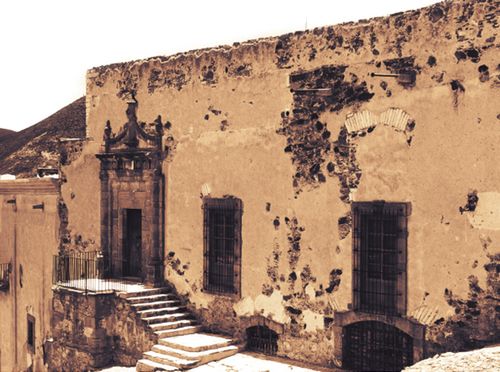
The minting machinery was purchased in Philadelphia from the Makers and Morgan Company, by Anacleto Terán and Anastasio García, the cost of the equipment was $80,000 gold pesos. All the tools were shipped and installed in the facilities that Santos de la Maza had built in the main square of the town, at a cost of $80,000. For a short time, the San Luis Potosí mint lent machinery to Catorce while the one they had requested arrived. In the same vein, a new lease was requested from President Juárez, which was granted for a new extension of ten years.
Despite the above, problems were not long in coming. At the end of 1863, a letter signed by the military commander, Manuel Bailen, arrived ordering the suspension of all work. There was great pressure in San Luis Potosí due to the arrival of the Imperialist forces, who had already taken the capital and secured its Mint. Real del Catorce was taken over from December 1863 to March 1866, with the mint closing in 1864, reopening the following year.
On 23 January 1864, the Juaristas fled from Matehuala and the Imperialists immediately entered Real de Catorce, On that same date, the cabildo of the capital of San Luis Potosí requested the closure of the Real del Catorce mint by the wishes of the Imperial Regency. On 11 December 1864, Juárez ordered the closure of the mint (despite it being in the hands of the Imperialists), and a counter-order for its opening was given on 3 January 1865.
During its period of operation (1863 to 1869), the Real de Catorce mint went through two wars: the War of Reform and the French Intervention. It is worth mentioning that from 1857 to 1861 there were ten governors of the state, a sign of the constant change of ideals of the time.
The mint began operations on 17 May 1863 by die-cutting the first silver coins of 2, 4 and 8 reales, There were small interruptions but the die-cutting work continued until 28 November. The Juaristas were in the town before leaving and witnessed the first coinage of the new mint, it is even said that President Juárez himself was present (hypothesis not confirmed).
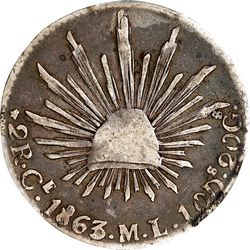
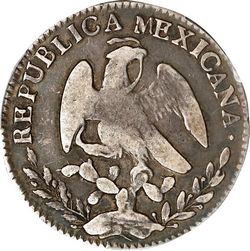
KM-374.1 Real de Catorce 2r (Stack’s Bowers auction, 16 May 2023, lot 70509)
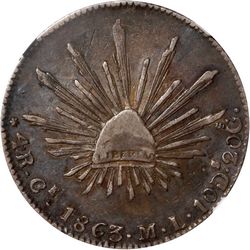
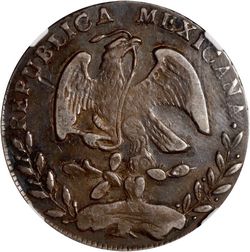
KM-375 Real de Catorce 4r small C (Stack’s Bowers auction, 23 February 2022, lot 37442)
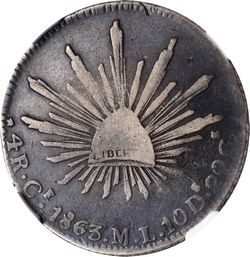
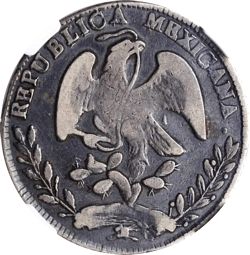
KM-375 Real de Catorce 4r large C (Stack’s Bowers auction, 24 June 2021, lot 72358)
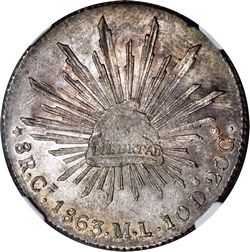
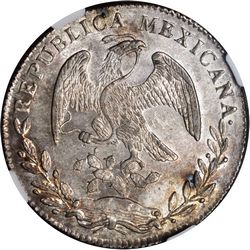
KM-377.1 Real de Catorce 8r (Stack’s Bowers NYINC auction, 14 January 2017, lot 3162)
Upon the arrival of Emperor Maximilian, fearful that Juárez's forces might take over the mint, he ordered its closure. Several letters were sent to the Emperor by the city council and citizens to revoke the decision, but Maximilian did not budge and the order stood.
In addition to these first complications, the governor of the state, Santos Degollado, imposed a forced loan of $20,000 on Real del Catorce: the leading miners as well as the city council refused to grant them, so Santos de la Maza was arrested. Due to this bad behaviour, a new forced loan for $35,000 was imposed shortly after, but as the coffers ce were almost empty, only less than half could be collected.
In August 1866 the town was again occupied by the Liberal colonel Pedro Martínez, the colonel's troops looted the town but found no more than 300 pesos, the soldiers broke into the facilities of the (now inactive) mint, stole machines and materials and broke the rest. It is important to mention that the minting presses had been moved to the capital in previous years, so the vandals only destroyed minor machinery.
The order to close the mint sent by Maximilian was administratively enforced in February 1866 through General Mejía with the main objective that the Juaristas could not make money. Months before, he had made administrative changes in the workforce of several mints, including Real del Catorce. Thus, in February 1866 he appointed Francisco Villar as assayer at Real del Catorce. Villar resigned shortly after, so in March of the same year Trinidad Gómez Gordillo was appointed assayer. However, neither of these has their initials on coins as "M.L." (Mariano León) appears on all issues.
In February 1865, the Prefect of the Empire, Darios de los Reyes, mentioned in a report that Real del Catorce mint represented losses to the treasury, compared to other mints, and requested that the contract be reviewed and nullified.
Due to all these complications, the town gradually lost its years of splendour, people closed their businesses and left, many moving to Matehuala taking advantage of the fact that it was also a relevant mining area. When Juárez restored the Republic, peace and security gradually returned, but stability was really consolidated in the last two decades of the nineteenth century during the administration of President Porfirio Díaz: In those years Real del Catorce returned to functioning, the mines re-opened and businesses returned to work.
The only date is 1863. Dunigan & Parker Mike Dunigan and Parker, Resplandores, 1998 argue that in 1864 and 1865 coins were dated 1863, so as not to offend the Imperialists, who had arrived in Mexico in 1864. On this same subject, Richard G. DotyRichard G. Doty, 1992 suggests that during the period of the Second Empire (1863-1867) multiple mints minted coins with dates prior to the intervention, such as Mexico City or Zacatecas, of which there is an abundance of coins from 1863, compared to other nearby years. This was because the tenants of the mint, not knowing how the precarious social, economic and political situation of the time would turn out, preferred to "shield" themselves and avoid trouble.
There is a possibility, according to Pradeau, that copper coins were issued at the mint in mid-1864, since there is a document that obliges the citizens of the area to accept as official currency the copper coins are minted at the Mint[text needed].
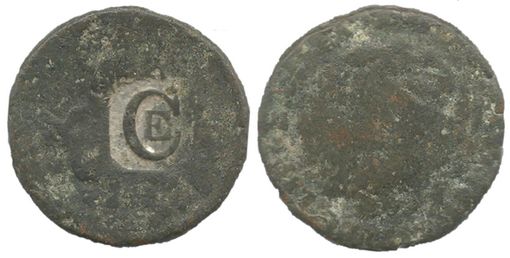 This coinlisted in Frank W. Grove, Tokens of Mexico, with number 2022 was minted (or restamped) on cuartillas or octavos of San Luis Potosí dated in 1859. The diameter of the piece is 21 millimetres, the restamp "Ce" is the abbreviation of the mint. There are varieties in stamps, the rarest being the one with stars surrounding the "Ce".
This coinlisted in Frank W. Grove, Tokens of Mexico, with number 2022 was minted (or restamped) on cuartillas or octavos of San Luis Potosí dated in 1859. The diameter of the piece is 21 millimetres, the restamp "Ce" is the abbreviation of the mint. There are varieties in stamps, the rarest being the one with stars surrounding the "Ce".
Finally, the State Legislature decreed the closure of the Mint on 15 November 1869, approved by the governor of the state, General Mariano Escobedo. Minting operations ceased on 28 November 1869Pradeau,(/footnote). In a last attempt at survival, the Legislature approved a request to maintain the assay office until 1872, the year in which all operations officially ended.
During its years of operations Real de Catorce minted currency for a total of 6,281,008.25 pesos, 95% of it in 8 reales coins. However, it seems that this amount refers only to the coins minted in 1863. Montejano AguiñagaRafael Montejano y Aguiñaga, “Las Acuñaciones de El Real del Catorce, S.L.P.” in the Gaceta de la Sociedad Numismática de Monterrey, April 1980 reports that the mint produced coins for $1,321,545 in 1865 and $167,860 pesos in 1866, which should probably be added to the previous amount. Pradeau, mentions that the mint was reopened on 16 February 1865, minting in that same month 65,000 pesos.
Pomposo Sanabria was an engraver in San Luis Potosí from 1827 to 1861, and worked for Real de Catorce from 1863. In the 8 Reales coins of 1863 we can find the variety "Ce/Pi" this is due to the fact that several dies from San Luis Potosí were re-used in Real de Catorce, with only the mint and assayer changed in the matrix. There is also a ML/C variety, that is, with the Catorce assayer Mariano León, on a coin previously used in San Luis Potosí by the assayer M.C. (Mariano Cataño).
As a final reflection we can find several reasons why this mint was not a success despite being in a rich mining area. The first was its proximity to the mint of the capital, San Luis Potosí. In history this proximity to other mints always ends badly, as happened to the mint of Tlalpan with that of Mexico City. A second reason was the the political situation, with the conflict between the pro-imperialist conservatives and the pro-Juárez liberals. Thirdly, Real del Catorce is in a complicated geographical area, which made it difficult to transport and distribute its silver. And finally, the mint had the envy of its neighbour in Mexico City. Before the mint was established in Real de Catorce all the silver was sent to the capital (which opened its mint in 1827: when this ceased it angered the capital's residents.
The building where the Mint was located was returned to Santos de la Maza, where it became his offices, known as "Casa Maza." Today it is the "Centro Cultural Real del Catorce" where cultural events are held.
Mínt owners or lessees and their tenures
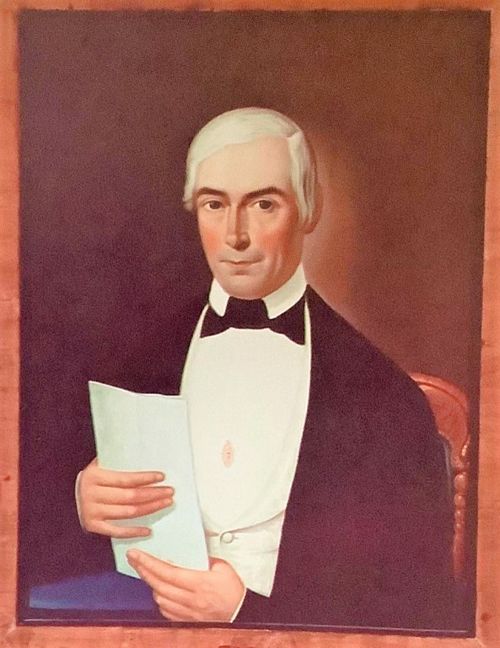
| from | to | |
| 12 February 1861 | 28 November 1869 | Jorge Santos de la Maza, Miguel M. de Alavia and Viceme lrizan |
Assayers and their tenures (as evidence by coinage)
| Initial | Name | Began on | Left office on |
| ML | Mariano LeónMariano de León received an annual salary of $1,500 pesos for his services | 1863 | 1863 |
